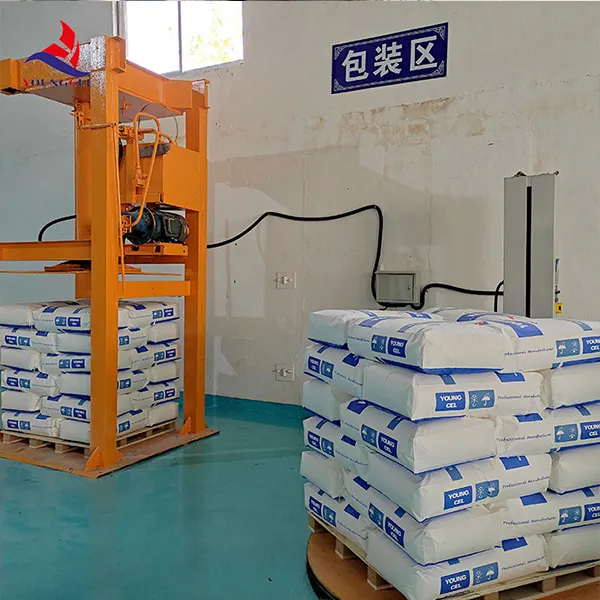Understanding Cellulose Ether The Case of Hydroxyethyl Methyl Cellulose (HEMC)
Cellulose is one of the most abundant organic polymers on Earth, primarily derived from plant cell walls. Among various cellulose derivatives, cellulose ethers play a crucial role in a multitude of industrial applications. One particularly noteworthy cellulose ether is Hydroxyethyl Methyl Cellulose (HEMC), which combines the properties of both hydroxyethyl and methyl groups. This article explores the characteristics, production, and applications of HEMC, highlighting its significance in various sectors.
Properties of Hydroxyethyl Methyl Cellulose (HEMC)
HEMC is a white, odorless powder that is soluble in cold water but forms a gel-like solution upon heating. It is a non-ionic cellulose ether, making it chemically stable and resistant to electrolytes, which means it maintains its properties even in the presence of saline solutions. Due to its unique structure, HEMC exhibits excellent film-forming abilities, high viscosity, and remarkable retention of water, which significantly enhances its utility in numerous formulations.
One of the key properties of HEMC is its ability to provide controlled viscosity in aqueous solutions. The degree of substitution, which refers to the number of hydroxyl groups replaced by hydroxyethyl and methyl groups, can be tailored during production to achieve specific viscosity levels. This adaptability allows manufacturers to control the performance characteristics of HEMC according to the requirements of various applications.
Production of HEMC
The production process of HEMC typically involves three main steps the alkalization of cellulose, etherification, and finally, the purification and drying of the product. Firstly, cellulose is treated with an alkaline solution, which disrupts its crystalline structure, making it more accessible for subsequent chemical reactions. In the etherification step, the treated cellulose reacts with ethylene oxide and methyl chloride, resulting in the formation of hydroxyethyl and methyl groups on the cellulose backbone.
After the etherification process, the mixture undergoes a series of purification steps to remove any unreacted or excess reagents. The final product is then dried to obtain a stable, free-flowing powder. The entire process requires careful control of reaction conditions to achieve the desired degree of substitution and thus, the desired viscosity.
cellulose ether hemc

Applications of HEMC
The versatility of HEMC is evident in its wide range of applications across different industries
1. Construction HEMC is widely used in the formulation of cement-based materials. It improves workability and open time, allowing construction workers to have a more extended period to work with the materials before they set. Additionally, HEMC enhances water retention, which is crucial for preventing cracking and improving the overall durability of concrete structures.
2. Pharmaceuticals In the pharmaceutical sector, HEMC serves as a binder and thickening agent in various formulations, including tablets and suspensions. Its ability to form gel-like solutions is particularly advantageous in controlled-release formulations, where it can modulate the release of active ingredients over time.
3. Food Industry HEMC is also used as a thickening and stabilizing agent in various food products. It helps improve texture and mouthfeel, especially in sauces, dressings, and dairy products. Additionally, it can act as a fat replacer, enabling the formulation of low-fat alternatives without compromising taste or texture.
4. Cosmetics and Personal Care In cosmetics, HEMC is employed as a thickener in creams, lotions, and gels. Its film-forming properties help in creating a pleasant application experience and enhancing the longevity of products on the skin.
Conclusion
Hydroxyethyl Methyl Cellulose (HEMC) is a remarkable cellulose ether that stands out due to its versatile properties and wide range of applications. Its ability to enhance texture, improve stability, and control viscosity makes it an essential ingredient in various industries, including construction, pharmaceuticals, food, and cosmetics. As research and technology advance, the potential uses of HEMC are likely to expand, further solidifying its importance in modern manufacturing and formulations. Understanding HEMC not only sheds light on the capabilities of cellulose derivatives but also opens up pathways for innovation in product development across multiple sectors.
-
A Comprehensive Guide to Methyl Ethyl Hydroxyethyl Cellulose: Applications and Industry InsightsNewsNov.24,2025
-
Understanding Methyl 2 Hydroxyethyl Cellulose: Uses, Benefits & Industry InsightsNewsNov.24,2025
-
Hydroxyethyl Methyl Cellulose HEMC: Industrial Uses, Benefits & Future TrendsNewsNov.23,2025
-
HEMC Cellulose: Versatile & Sustainable Industrial Polymer | YoungcelNewsNov.23,2025
-
Methyl Hydroxyethyl Cellulose: Versatile Building Block for Industry & SustainabilityNewsNov.23,2025
-
CAS 9032 42 2: Understanding Polyvinyl Alcohol's Impact on Industry & SustainabilityNewsNov.22,2025




